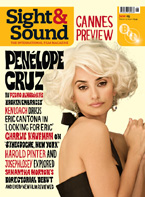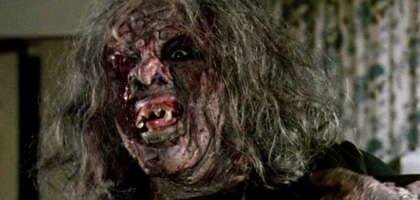Primary navigation


Tim Lucas rediscovers the flawed but fascinating debut of 'Witchfinder General' director Michael Reeves
The She Beast
Michael Reeves; UK/Italy 1966; Dark Sky Films; Aspect Ratio 2.35:1; Features: audio commentary with actors Barbara Steele and Ian Ogilvy and producer Paul Maslansky, photo gallery
On 11 February 1969, British film-maker Michael Reeves died of an accidental barbiturate overdose at the age of 25. The news of his death resonated apace with the climactic scream of his third and final feature, Witchfinder General (1968), and it may well have been the despairing tenor of that scream, particularly in the political context of its era, that persuaded so many for so long that Reeves had actually committed suicide. Just as Witchfinder's cynicism went on to make downbeat endings de rigueur in the horror genre for years to follow, so its romanticism attached itself to the young director's thwarted promise; early valentines to his brief career, penned by Robin Wood and in particular David Pirie (in A Heritage of Horror), soon made him legendary among the cognoscenti. Thirty years later, when his abandoned work was either succumbing to mould in storage vaults or being circulated on video in patchwork-quilt reconstructions or with different music attached, the impact of Reeves' death remained a compelling point of attraction for a certain breed of film fan. Almost ten years ago, I found myself consoling the widow of someone who committed suicide not long after acquiring a bust of Michael Reeves; it fell to me to explain to her who he was.
For decades, Reeves' films have been so difficult to see in authoritative versions that they have, finally, become more important than the tabloid value of his early death. After decades of availability only in a diluted synth-rescored version, Witchfinder General is now available from MGM with all its US-cut violence and original Paul Ferris score intact. His second film, The Sorcerers (1967) with Boris Karloff, was issued as a now out-of-print UK DVD in 2004. And now, after literally 40 years of ultra-grainy, incoherently cropped, VHS-sourced transfers, his debut The She Beast (1966) has re-emerged from unpaid storage hell with its original 2.35:1 Techniscope framing intact.
The She Beast isn't a good film by any stripe: though it runs less than 80 minutes, it feels padded by at least 30, and star Barbara Steele grew so contemptuous of the production (hired for a day, she was worked 22 hours straight) that she spent much of her screen time under a hat and behind sunglasses and didn't speak to producer Paul Maslansky for the next ten years. The plot, thin as it is, owes much to Mario Bava's La maschera del demonio (Black Sunday, 1960), which made Steele a star: in 1765, the witch Vardella is put to death by being dunked in Romania's Lake of Mists; 200 years later, a car accident deposits Veronica (Steele) in said lake, sending her into limbo and freeing Vardella, who visits her vengeance on the descendants of her torturers. Reeves was assisted on the film by its uncredited co-author Charles B. Griffith (Little Shop of Horrors), whose quirky persona is evident in various satiric asides about Romania's then status as a communist country, and in its forever winking, self-conscious dialogue ("Terrible line, darling - great alliteration, but terrible line"). Griffith also supervised the interminable, undercranked road-chase second-unit sequence, which interrupts the climax for an entire reel like a madcap outtake from a Dr Goldfoot movie.
For all its faults, The She Beast burrows under the skin thanks to some scenes of unusual power and visual imagination - the dunking sequence, for example, conveys such a shrill sense of the tortured witch's pain that we sympathise with her, though she is quite literally a monster. Later, in the film's most audaciously symbolist moment, Vardella bloodily murders a man with a sickle, which she then hurls across the room, where it lands neatly across a hammer. It is also compelling in hindsight for containing so many sequences and shots that are unmistakably the work of the young man who made Witchfinder General. The 2.35:1 anamorphic transfer is mostly clear of grain and looks remarkably sharp and colourful for a film shot in Cromoscope - what Techniscope (a budget-conscious two-perf widescreen gauge) was called when it was processing other than by Technicolor. Seeing The She Beast restored to its original ratio isn't going to raise its stature much among horror devotees, but at least the film Reeves made can once again be properly seen and judged - for the first time in more than 40 years.
In a lively and candid audio commentary, Maslansky, Steele and co-star Ian Ogilvy reminisce about the Italian guerrilla shooting of this 21-day effort, reportedly financed with £17,000 of Reeves' own money and shot with the title 'Etruscan Ruins' on the clapperboard to take advantage of an Italian tax-break for documentaries. The speakers (including moderator David Gregory) respect Reeves but are also thankfully careful not to credit him with too much genius, sussing out when a 'Reeves shot' is actually a set-up copped from The Seventh Seal or something by Kurosawa. This level of alertness is useful to appreciating Reeves for something closer to what he really was: a remarkable autodidact who learned more from watching films obsessively and independently than his most talented film-school peers - Coppola, Bogdanovich, De Palma and Spielberg - were capable of putting onscreen during his lifetime. It is better to focus on this, his real achievement, than on the fantasy of what he might have done had he lived.